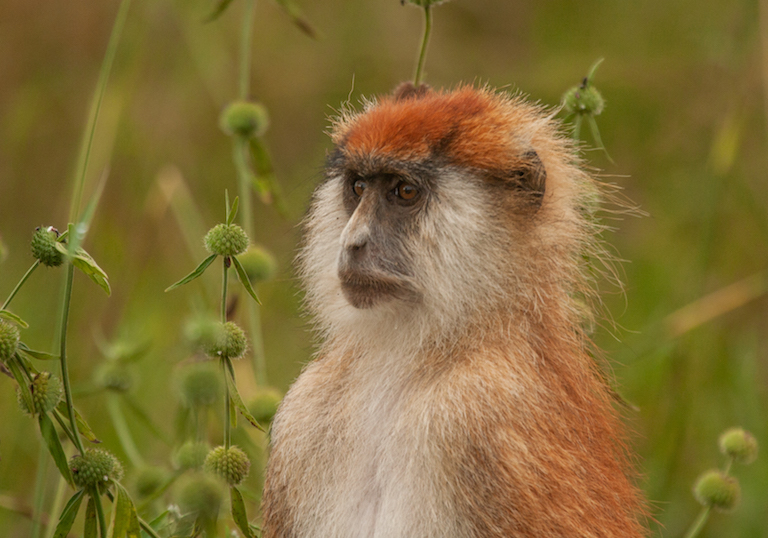- New research into the little-known southern patas monkey indicates that fewer than 200 of these primates remain, all confined to protected areas in northern Tanzania.
- Without intervention, researchers say, the species could die out within a decade, as it faces mounting pressure from habitat loss and fragmentation, hunting and competition for food and water.
- Despite the grim situation, experts say quick, well-targeted conservation actions can still save the species.
The southern patas monkey, a little-known and rarely seen African primate, is on the verge of extinction, new research shows.
Primate experts say they hope to bring international attention to its plight and spur efforts to save it.
Recently published research into the southern patas monkey (Erythrocebus baumstarki) sheds light on its natural history, but also shows how close the animal, which is already designated as critically endangered on the IUCN Red List, is to dying out.
Having once been present in Kenya, from where it was extirpated in about 2015, the historic range of the species has declined by about 85% since the early 20th century, due to the growing human population, according to study authors Yvonne de Jong and Thomas Butynski. The monkey is currently restricted to the protected areas of the western Serengeti in northern Tanzania.

The study estimates that there are between 100 and 200 southern patas monkeys remaining, including between 50 and 100 mature individuals. If this decline continues unchecked, the researchers estimate the species could be extinct within a decade. “This poorly known but charismatic primate is silently and rapidly going extinct,” De Jong told Mongabay.
However, the researchers say the species can still be saved. “With immediate, focused, and effective conservation action and research, there is hope for the southern patas monkey,” De Jong said.
Relatively little is known about the southern patas monkey, one of only three known species from the patas monkey genus, Erythrocebus, endemic to the African tropics. Although large, patas monkeys are shy, move very fast, and occupy large home ranges, making them difficult to study. Densities of southern patas monkeys in particular appear to be naturally low, meaning they are rarely encountered.
Added to this, the southern patas monkey was long thought to be a subspecies of the patas monkey, Erythrocebus patas, and thus was little-studied on its own. However, in recent years the taxon has become widely accepted as a species in its own regard.
The lack of knowledge about the monkey, and the rarity of encounters with it, may be part of the reason why its dire predicament has not gained more attention, even among primate experts.
“Even within the primate research community I doubt many people knew how threatened this particular monkey was,” Dietmar Zinner, senior scientist at the German Primate Centre in Göttingen, Germany, told Mongabay. “They were always at the niche border of this [patas] species and we have little information about them.”

De Jong and Butynski, both with the Kenya-based Eastern Africa Primate Diversity and Conservation Program, say it’s vital that awareness is raised internationally about the existential threat to the monkey.
“Here is a large, attractive, and interesting primate on the verge of extinction due to rapidly growing human population,” Butynski said, “and nobody seems to notice. The objective of our study is to bring attention to the plight of this poorly known species, thereby promoting its long‐term conservation.”
The biggest threats the monkeys face are, as with so many endangered animals, a very rapidly increasing human population.
The degradation, loss and fragmentation of natural habitats, and the related competition with people and livestock for habitat and water, particularly during droughts, as well as poaching by humans and hunting by dogs, are putting pressure on the species, according to De Jong and Butynski.
There have been no local conservation efforts for the monkey, the researchers say. They suggest this may be down to the fact it is so poorly known and that there are many other, larger and more abundant species in the region.
De Jong and Butynski have made nine specific recommendations for conservation measures to combat these threats and help the species recover. These include regular research and surveys to gain more knowledge of the monkey; establishing dedicated, reliable, wildlife water sources in its range; stopping poaching; and creating a conservation plan for it and ensuring that plan is implemented by conservation authorities in Tanzania.
The region’s growing human population means the threats faced by southern patas monkeys are high, said Zinner, who was not involved in the recent study. But he said the species can be saved.
“These monkeys do have a chance,” he said. “Some species can and have recovered from even lower numbers,” he said.
“The numbers are low but not a reason to lose hope,” Serge Wich, professor of primate biology at Liverpool John Moores University in the U.K., told Mongabay. “We can save species with only a few hundred individuals left if we protect them, if sufficient resources and effort go into it. If the threat mitigation recommendations in this paper are met, this species can be saved.”
Wich, who was not involved in this study, added: “It may not be easy, but we need to try, and not just for the future of this species. By and large, the threats this monkey is facing are the same threats other endangered animals face all over the world. If we can solve the threats for these monkeys, we can maybe solve the threats for more species.”
Citation:
- De Jong, Y. A., & Butynski, T. M. (2021). Is the southern patas monkey Erythrocebus baumstarki Africa’s next primate extinction? Reassessing taxonomy, distribution, abundance, and conservation. American Journal of Primatology, 83(10). doi:10.1002/ajp.23316
FEEDBACK: Use this form to send a message to the author of this post. If you want to post a public comment, you can do that at the bottom of the page.